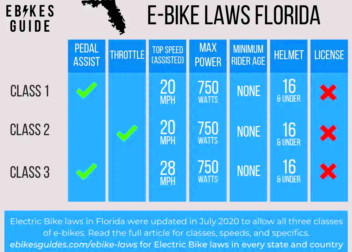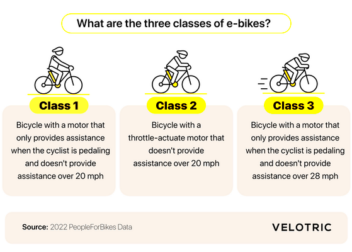Understanding Illinois E-Bike Laws
Illinois has been getting serious about regulating bikes or e bikes. If you love cycling or are simply curious about these electric marvels it’s crucial to be aware of the rules in place. Figuring out e bike laws in Illinois can feel like decoding a map without a compass; there are many intricacies and they vary based on your location. From my perspective grasping these regulations can help you avoid fines and ensure a ride. Whether you’re commuting or taking a leisurely stroll knowing the laws will enhance your experience and make it smoother sailing.
Classification of E-Bikes in Illinois
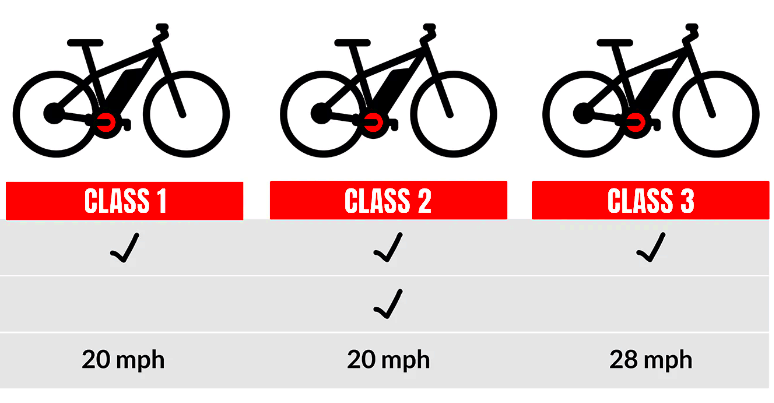
In Illinois e bikes are classified into three separate categories, each having its own regulations.
- Class 1: These e-bikes are equipped with a motor that only assists while pedaling and stops assisting when the bike reaches 20 mph. They are allowed on most bike paths and trails.
- Class 2: These have a motor that can propel the bike without pedaling, but it stops assisting once the bike hits 20 mph. These bikes are typically permitted on roads but may have restrictions on certain trails.
- Class 3: These are like Class 1 e-bikes but can assist up to 28 mph. They are not permitted on some trails and require riders to wear helmets, regardless of age.
Grasping these categories is essential as it influences the places and ways you can use your e bike. Personally I found that being well informed about these classifications has enhanced my riding experiences without any legal complications. Be sure to review the rules in your area since certain locations might have specific restrictions or permissions.
Regulations for E-Bike Operation on Public Roads
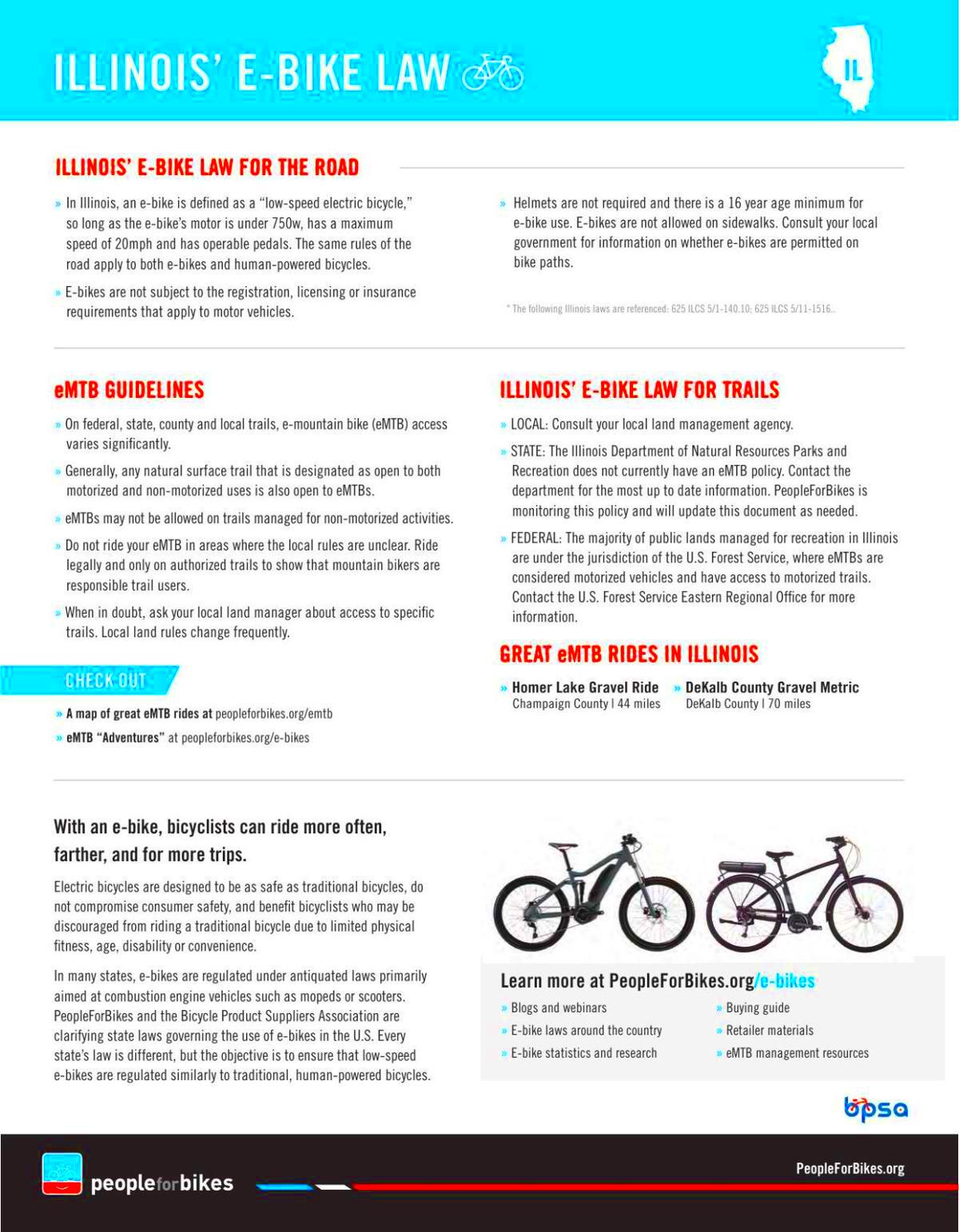
If you plan to ride your e bike on the streets of Illinois there are a few important rules you should be aware of.
- Speed Limits: E-bikes are generally subject to the same speed limits as traditional bicycles. For Class 3 e-bikes, the maximum speed limit is 28 mph, but it’s important to adhere to any posted speed limits on roads and bike paths.
- Lane Use: E-bikes can be ridden in bike lanes and on roadways where bicycles are permitted. However, they should not impede motor vehicle traffic and must yield to pedestrians.
- Helmet Requirements: While helmet laws vary by class, it’s strongly recommended for all e-bike riders to wear helmets for safety, particularly when riding Class 3 e-bikes.
Based on what I’ve seen following these guidelines not only protects you but also helps you stay on the right side of the law. Theres a sense of reassurance that comes from knowing you are riding in a manner and within the bounds of legality. Be sure to familiarize yourself with the rules in your area since different municipalities may have their own restrictions or requirements.
Rules for E-Bikes in Parks and Trails
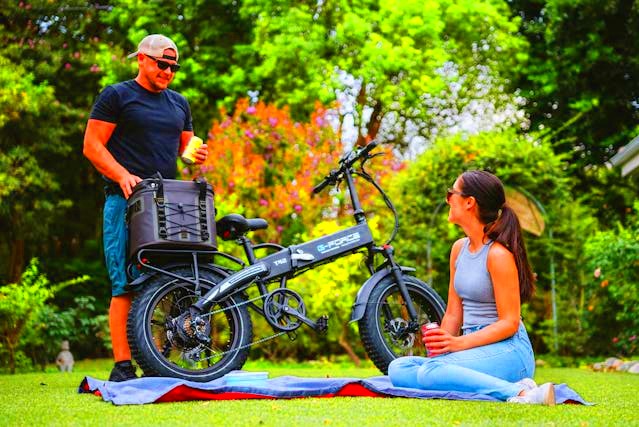
Cruising on an e bike through the parks and trails in Illinois can be a joyful adventure blending the excitement of electricity with the charm of the great outdoors. However adhering to certain guidelines is essential to maintain a ride that is considerate and enjoyable for all. Drawing from my personal experiences and input from other cyclists here are the key points to keep in mind.
- Trail Access: Not all trails are open to e-bikes. Some parks and nature reserves restrict their use to protect wildlife and maintain the natural environment. Always check local trail regulations before setting out. It’s a good idea to visit park websites or contact park authorities to confirm.
- Speed Limits: Many trails impose speed limits to ensure safety. E-bike riders must adhere to these limits, which are usually lower than those on roadways. This helps to prevent accidents and ensures a pleasant experience for all trail users.
- Trail Etiquette: Just as with traditional bikes, e-bike riders should yield to pedestrians and stay on designated paths. It’s important to be courteous and signal when passing others to avoid startling them.
Based on what I’ve seen sticking to these guidelines not only helps you steer clear of penalties but also adds to the pleasure of the ride. It’s really about being a rider and showing consideration for areas. By using the trails in a way we can make sure they stay open for everyone to enjoy now and in the years to come.
Helmet and Safety Gear Requirements
When it comes to riding an e bike prioritizing safety is crucial. In Illinois there are laws in place that outline specific rules for helmets and safety equipment. Based on my personal rides and the stories of fellow riders here’s a summary of what you need to know.
- Helmet Use: For Class 3 e-bikes, wearing a helmet is mandatory for riders under 18 and recommended for everyone. Helmets are crucial for protecting your head in case of accidents, and many e-bike riders, including myself, have found them to be indispensable.
- Additional Safety Gear: While not legally required, using safety gear such as reflective clothing, gloves, and knee pads can significantly reduce the risk of injury. Visibility is key, especially when riding in low-light conditions or heavy traffic.
- Proper Maintenance: Ensure your e-bike is in good working order. Regularly check the brakes, tires, and battery to avoid mechanical issues that could lead to accidents.
I believe that putting on safety gear goes beyond just obeying the rules; it’s about ensuring a smooth and enjoyable journey. Spending a little on it brings you peace of mind and significantly boosts your sense of security and confidence while riding your e bike.
Registration and Insurance Requirements
In Illinois the rules for registering and insuring e bikes depend on their category and how they are used. Drawing from my experiences and findings here are some key points to keep in mind.
- Registration: Currently, e-bikes are not required to be registered with the state. However, local municipalities may have their own rules, so it’s wise to check with your city or county for any specific registration requirements.
- Insurance: Unlike motor vehicles, e-bikes do not require insurance. Nonetheless, it’s a good idea to consider personal liability insurance to cover potential accidents or damage. Many riders, including myself, find this extra step provides added security.
- Legal Protection: Keeping records of your e-bike purchase, including the serial number and proof of purchase, can be helpful in case of theft or legal issues. This documentation can assist law enforcement in recovering your bike if needed.
I think even though registration and insurance may not be required their presence can bring a sense of reassurance. Its always wise to be ready and safeguarded so you can fully enjoy your journey without fretting over possible problems.
Penalties for Violating E-Bike Laws
Recognizing the repercussions of violating e bike regulations in Illinois holds equal importance to grasping the rules themselves. Through my personal experiences and those of fellow cyclists Ive come to realize that the penalties can be quite exasperating and expensive. Here’s a brief overview of what you could encounter if you fail to comply with the guidelines.
- Fines: Depending on the violation, fines can range from minor to substantial. For example, riding a Class 3 e-bike on a trail where it’s not allowed can result in fines ranging from $50 to $200. It’s a bitter pill to swallow, especially when you’re just trying to enjoy a ride.
- Impoundment: In some cases, e-bikes can be impounded if they’re being used in a manner that violates local ordinances. This is usually a last resort but can be an expensive and inconvenient process to retrieve your bike.
- Points on License: While e-bikes themselves don’t affect your driving record, certain violations related to road usage might result in points on your driver’s license. This can have ripple effects on your insurance rates and driving privileges.
Based on what I’ve seen the key to steering clear of these penalties is staying up to date and being careful. It’s definitely a good idea to familiarize yourself with the laws in your area before hitting the road because they can differ significantly depending on your location. By making sure you follow the rules you not only avoid getting into trouble but also help create a riding atmosphere for everyone.
Resources for E-Bike Riders in Illinois
When it comes to exploring the realm of e bikes having access to the right information can truly impact your experience. Drawing from my personal journey and insights from fellow enthusiasts I wanted to share a few helpful resources for e bike riders in Illinois.
- Illinois Department of Transportation (IDOT): Their website provides up-to-date information on traffic laws, including e-bike regulations. It’s a good starting point for understanding the legal landscape.
- Local Bike Shops: Many bike shops offer resources and advice on local e-bike laws and safety. The staff at these shops often have firsthand experience and can offer practical tips and guidance.
- Online Forums and Groups: Joining e-bike forums and social media groups can connect you with other riders. These communities often share updates on laws, safety tips, and personal experiences that can be incredibly useful.
- Municipal Websites: Check your city or county’s website for specific regulations and updates on e-bike usage in your area. Local governments often have the latest information on rules and enforcement.
In my opinion staying in touch with these resources has been incredibly valuable. They not serve as a source of information but also create a sense of community and assistance. Regardless of whether you’re an experienced rider or a beginner when it comes to e bikes these resources can enrich your riding journey and ensure that you adhere to legal regulations.
Frequently Asked Questions
When it comes to laws regarding e bikes there are often a few questions that arise frequently. Drawing from my conversations and findings here are some responses to inquiries that can help shed light on the matter.
- Do I need a license to ride an e-bike in Illinois? No, you do not need a special license to ride an e-bike. However, different classes of e-bikes may have specific requirements regarding helmet use and where they can be ridden.
- Are there any specific age restrictions for riding e-bikes? For Class 3 e-bikes, riders under 16 are not permitted to ride. It’s always a good idea to ensure you’re complying with age restrictions to avoid any issues.
- Can I ride my e-bike in a bike lane? Yes, e-bikes are generally allowed in bike lanes, but make sure to follow the local regulations regarding the type of e-bike and any specific rules for bike lanes.
- What should I do if I get stopped by the police for a violation? Stay calm and courteous. Provide any necessary documentation and be prepared to discuss your e-bike’s class and usage. It’s helpful to be informed about the specific laws to address any concerns effectively.
From what Ive seen being prepared with answers to these frequently asked questions can help you avoid any confusion and make your ride smoother. It really comes down to being ready and informed which in the end enhances your overall experience whether you’re on the road or exploring a trail.
Conclusion
If you’re planning to hit the trails on an e bike in Illinois it’s crucial to familiarize yourself with the laws governing electric biking. Whether it’s about classifying your e bike knowing where you can ride or what safety gear you should have a solid understanding of these regulations is key to ensuring a ride. Personally I’ve found that staying updated on the rules has helped me avoid fines and enjoy a seamless biking experience. Remember the secret to an e bike adventure lies in staying well informed and respectful of the existing regulations. By doing you play a role in creating a riding environment for everyone. So get ready stay informed and have an amazing time biking!

